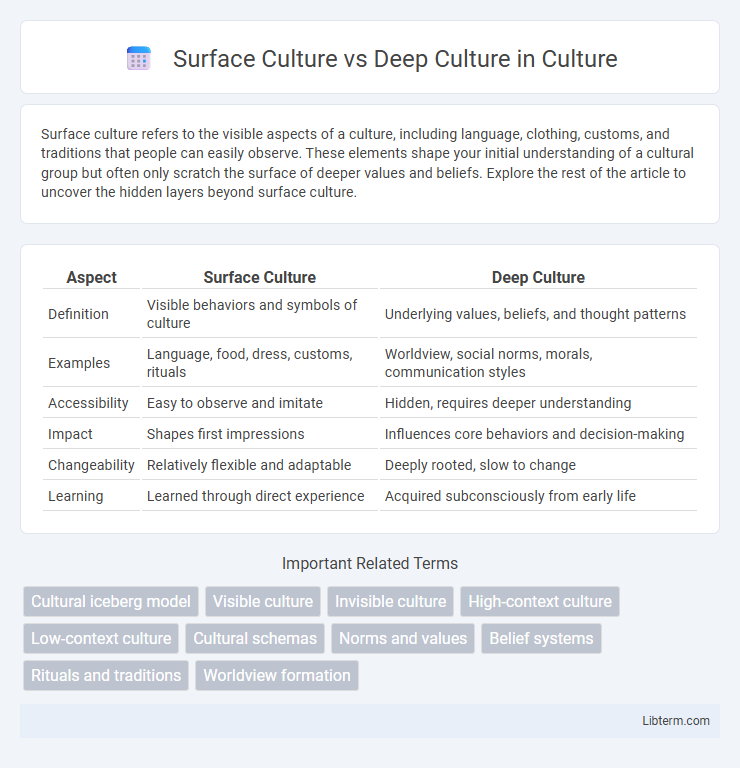Surface culture refers to the visible aspects of a culture, including language, clothing, customs, and traditions that people can easily observe. These elements shape your initial understanding of a cultural group but often only scratch the surface of deeper values and beliefs. Explore the rest of the article to uncover the hidden layers beyond surface culture.
Table of Comparison
| Aspect | Surface Culture | Deep Culture |
|---|---|---|
| Definition | Visible behaviors and symbols of culture | Underlying values, beliefs, and thought patterns |
| Examples | Language, food, dress, customs, rituals | Worldview, social norms, morals, communication styles |
| Accessibility | Easy to observe and imitate | Hidden, requires deeper understanding |
| Impact | Shapes first impressions | Influences core behaviors and decision-making |
| Changeability | Relatively flexible and adaptable | Deeply rooted, slow to change |
| Learning | Learned through direct experience | Acquired subconsciously from early life |
Understanding Surface Culture vs Deep Culture
Surface culture includes visible aspects like language, food, clothing, and customs, which are easy to observe and learn. Deep culture encompasses underlying values, beliefs, thought patterns, and social norms that influence behavior and perception but remain hidden beneath the surface. Understanding the distinction between surface culture and deep culture is essential for effective cross-cultural communication and fostering genuine intercultural relationships.
Key Characteristics of Surface Culture
Surface culture includes visible and tangible aspects such as language, clothing, customs, food, and rituals that are easily observed and recognized by outsiders. These elements reflect the external expressions of a culture and serve as initial identifiers in social interactions. While surface culture is explicit and can be quickly learned, it only represents a small fraction of the deeper values, beliefs, and thought patterns embedded in deep culture.
Defining Deep Culture: Beyond the Obvious
Deep culture encompasses the underlying values, beliefs, and thought patterns that shape behaviors beyond visible customs and traditions. It includes cognitive frameworks, emotional responses, and social norms ingrained in a community's collective identity, often unconscious to its members. Understanding deep culture is essential for meaningful intercultural communication and overcoming misunderstandings rooted in non-observable cultural factors.
Examples of Surface Culture Elements
Surface culture includes visible and tangible elements such as clothing styles, food, language, holidays, and customs that are easily observed in everyday interactions. Examples encompass traditional dress like Japan's kimono, cuisine such as Italian pasta, spoken language variations, popular festivals like Diwali, and social etiquette rituals. These surface elements provide initial cultural cues but only scratch the surface of deeper cultural values and beliefs.
Exploring Deep Culture: Beliefs, Values, and Norms
Deep culture encompasses the underlying beliefs, values, and norms that drive behaviors and shape perceptions within a community, contrasting with visible surface culture such as customs and language. Understanding deep culture requires exploring core principles like family dynamics, societal roles, ethics, and worldviews that influence decision-making and interpersonal relationships. This profound level of cultural knowledge enhances cross-cultural communication, fosters empathy, and reduces misunderstandings by revealing motivations behind surface actions.
Impact of Surface and Deep Culture on Communication
Surface culture includes visible elements such as language, customs, and dress that influence initial interactions, often serving as entry points for communication. Deep culture encompasses underlying values, beliefs, and thought patterns that shape perceptions and responses, significantly affecting the interpretation and effectiveness of cross-cultural communication. Misunderstandings arise when communicators focus solely on surface culture without recognizing deep culture's role in shaping context and meaning.
Challenges in Recognizing Deep Cultural Differences
Recognizing deep cultural differences presents challenges due to their intangible nature, embedded in values, beliefs, and thought patterns that are not immediately visible like surface culture elements such as food or dress. Misinterpretation of these deep layers can lead to communication breakdowns, conflicts, and ineffective cross-cultural interactions, especially in diverse workplaces or international relations. Addressing these challenges requires cultural competence, empathy, and ongoing learning to uncover and respect underlying cultural norms and worldviews.
The Role of Surface and Deep Culture in Education
Surface culture includes visible elements like language, dress, and customs, which educators can easily observe and incorporate into teaching materials. Deep culture encompasses underlying values, beliefs, and thought patterns that influence students' behaviors and learning styles but are less visible and harder to address. Effective education requires acknowledging both surface and deep cultural dimensions to create inclusive environments that respect diversity and promote meaningful understanding.
Building Cultural Competence: Surface vs Deep Culture
Building cultural competence requires understanding both surface culture, which includes visible elements like food, language, and dress, and deep culture, encompassing values, beliefs, and thought patterns that shape behavior. Mastering surface culture facilitates initial interactions, while grasping deep culture enables meaningful connections and effective communication across diverse cultural contexts. Developing awareness of deep cultural norms enhances empathy, reduces misunderstandings, and fosters inclusive environments.
Bridging Surface and Deep Culture in Global Interactions
Bridging Surface and Deep Culture in global interactions requires recognizing the visible elements like language, dress, and customs alongside the underlying beliefs, values, and thought patterns that shape behavior. Effective cross-cultural communication depends on understanding both cultural layers to navigate misunderstandings and foster meaningful connections in international business, diplomacy, and social exchanges. Training programs emphasizing cultural intelligence and empathy enhance global collaboration by integrating surface-level awareness with deep cultural insights.
Surface Culture Infographic

 libterm.com
libterm.com